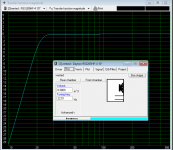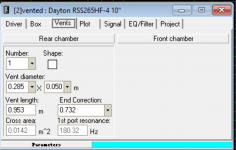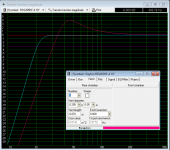Hey all, I'm new here 🙂
I've used winisd to design my first subwoofer using dayton 10" RSS265HF-4.
I tried to tune my vented speaker to 22Hz and I got a ridiculously big sub in size 30x60x60cm to make it to the required volume of 0.08m^3.
Can anyone tell what I did wrong? I saw speakers much smaller than this at 35x35x35 in size.
I've used winisd to design my first subwoofer using dayton 10" RSS265HF-4.
I tried to tune my vented speaker to 22Hz and I got a ridiculously big sub in size 30x60x60cm to make it to the required volume of 0.08m^3.
Can anyone tell what I did wrong? I saw speakers much smaller than this at 35x35x35 in size.
Attachments
I used a 12mm mdf and that really felt like the bass was concentrated to a specific area and it felt kind of weak in comparison to other 10" subs.
Hey all, I'm new here 🙂
I've used winisd to design my first subwoofer using dayton 10" RSS265HF-4.
The HO version of that subwoofer is supposed to be a better match for car audio use.
.45 qts
1.9ft3 vas
25.6hz fs
I read a while back, a jbl had f3 of 45hz in .707 sealed.
It measured flat to 8hz in a 100ft3 vehicle.
You have met hoffmans iron law.
Size - efficiency - low notes
You can get low f3 but it takes a bigger box.
I find a 15" needs 4-8ft3 for a standard ported box to have f3 just below 30hz.
1.9ft3 vas
25.6hz fs
I read a while back, a jbl had f3 of 45hz in .707 sealed.
It measured flat to 8hz in a 100ft3 vehicle.
You have met hoffmans iron law.
Size - efficiency - low notes
You can get low f3 but it takes a bigger box.
I find a 15" needs 4-8ft3 for a standard ported box to have f3 just below 30hz.
I saw speakers much smaller than this at 35x35x35 in size.
Greets!
This is a good size for sealed.
For vented, a Vb = [published] Vas/1.44 = 37.51 L tuned to 25.6 Hz [Fs] is 56 L net including a very large vent [140.32 cm^2 x 132 cm long] to handle its 350 W power rating down to Fs, so could be smaller if the power required is lower.
GM
The Qts is more suited for a closed cabinet with 37L Q=.707 40Hz
You can reach the same 40Hz with a tiny 14L enclosure when using a series capacitor of 900uF.
the efficiency is very low, with a 700W amp it will only reach 105dB free standing.
You can reach the same 40Hz with a tiny 14L enclosure when using a series capacitor of 900uF.
the efficiency is very low, with a 700W amp it will only reach 105dB free standing.
The HO version of that subwoofer is supposed to be a better match for car audio use.
I want to build a subwoofer for my living room. wouldn't that fit?
I'm sorry I'm quite confused from your answers, guys. Is the frequency response ok if it overshoots by 3db?
Depends on whether the sub is in a room null or peak or where it's between them, so the norm is to either use sealed or low tune a vented sub to give it a similar initial roll off slope as a compromise and use some form of EQ to finish blending it to the room.
In short, unless tone deaf, no.
GM
In short, unless tone deaf, no.
GM
Try bringing your F3 up a little tuning the port down to 22Hz is a bit low for that 10" and 80lt vented is to big, they seem to recommend around an F3 of 27Hz .
Im finding 50lt ported at 30Hz will give a F3 around 27hz while keeping port length practical and velocity reasonably low(2 of 86.5x718mm, its locally to me available pvc pipe).
Im using Winisd.
You will need a subsonic filter if using for HT use
Im finding 50lt ported at 30Hz will give a F3 around 27hz while keeping port length practical and velocity reasonably low(2 of 86.5x718mm, its locally to me available pvc pipe).
Im using Winisd.
You will need a subsonic filter if using for HT use
Last edited:
Nope, you can clearly hear +0.8dB.I want to build a subwoofer for my living room. wouldn't that fit?
Is the frequency response ok if it overshoots by 3db?
- Home
- Loudspeakers
- Subwoofers
- 10" subwoofer enclosure is too big



